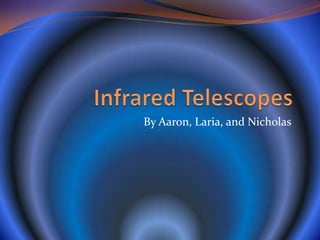
How Infrared Telescopes Work
- 1. By Aaron, Laria, and Nicholas
- 2. How do they work? Infrared telescopes by seeing infrared light and detecting what is around it by the heat that stars and celestial objects radiate. All objects radiate some heat unless they are at absolute zero. Depending on the telescope or used device it becomes different colors at certain intervals. For example black is the coldest and white is the hottest.
- 3. Why to we use infrared telescopes? Infrared radiation is heat. It is radiation in electromagnet that is at longer wavelengths then light we usually see with our naked eye. We can’t see it but we can feel it, for example on a sunny day. Infrared astronomy allows astronauts and astrophysicists the ability to measure the temperature of planetary bodies and stars and whatnot.
- 4. What do infrared telescopes need to function properly? Infrared telescopes must be built to minimize the amount of heat generated by the telescope itself. Since infrared telescopes emit a ton of heat, they need to be shielded from the heat by people containing them (or at least the ground-based telescopes) by containing them in liquid nitrogen. Infrared telescopes need electricity to function at all. Infrared light reciever
- 5. Pros and Cons: Pros Cons We can see how warm Infrared telescopes need to be celestial objects are. in a cold place if not Would be used to detect artificially chilled. foreign life forms. Produces a lot of heat on its Smaller than other own because of the heat telescopes. making the image inaccurate. Infrared telescopes are hard to use on land because of the heat in the atmosphere blocking a clear viewing.
- 6. Examples of Infrared Telescopes The Spitzer Space Telescope was the fourth and final of the NASA Great Observatories program. There are two observatories on Mauna Kea, Hawaii. They are at an altitude of 4205 meters. Kuiper Airborne Observatory, which operated from 1974 to 1995.
- 9. Bibliography Brasil, C. (n.d.). Chavals. Retrieved 1 24, 2013, from Flickr: http://www.flickr.com/photos/chavals/3656263494/sizes/l/in/photostream/ Farlex. (n.d.). Infrared Telescope. Retrieved 1 28, 2013, from The Free Dictionary: http://www.thefreedictionary.com/infrared+telescope Massey, D. R. (n.d.). Glorious Orion: UKIRT Helps Reveal Chaotic and Overcrowded Stellar Nursery. Retrieved 1 29, 2013, from Outreach Jach Hawaii: http://outreach.jach.hawaii.edu/pressroom/2009_orion/ NASA. (n.d.). PIA04267: SIRTF and the Milky Way, an Artist's Concept. Retrieved 1 29, 2013, from Nasa.gov: http://www.nasa.gov/multimedia/imagegallery/image_feature_27_prt.htm Ogilvie, P. (n.d.). How Does an Infrared Telescope Work? Retrieved 1 28, 2013, from eHow: http://www.ehow.com/how-does_4926827_infrared-telescope- work.html The Tarantula Nebula. (n.d.). Retrieved 1 25, 2013, from Spitzer.CalTech.edu: http://www.spitzer.caltech.edu/images/1121-ssc2004-01a-The-Tarantula-Nebula Wikipedia. (n.d.). Spitzer Space Telescope. Retrieved 1 28, 2013, from Wikipedia: http://en.wikipedia.org/wiki/Spitzer_Space_Telescope
- 10. Credits Laria: Telescope artistry, researcher, PowerPoint editor Nicholas: PowerPoint designer, researcher Aaron: Researcher, Bibliography, Telescope observatory artist